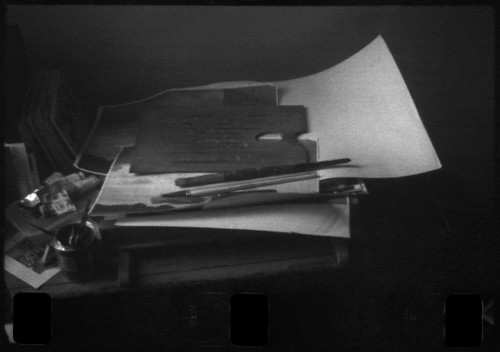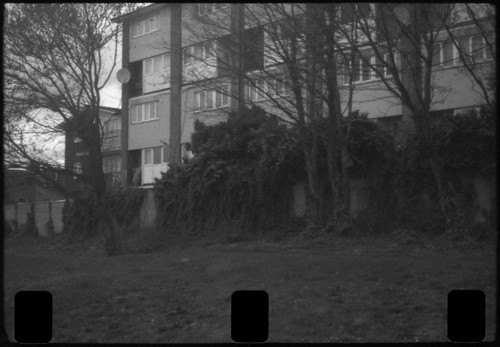 |
| Rollei 16 with Eastman Plus-X negative film |
This year's
Expired Film Day was scheduled for 13th-15th March. Initially I hadn't intended to take part in any way, but on the 13th itself, which was a Friday, I thought to check the date of the roll of Plus-X which was currently in my
Rollei 16 - the camera I'd been using for the previous week's
#FP4Party - and, after I'd finished the rolls of 1970s FP4, I'd reloaded the cassettes with
Eastman Plus-X negative film. Plus-X itself was discontinued ten years ago in 2010; the box for the 100ft roll of 16mm does not have a date - but the film does. As a motion picture film stock, the 16mm Plus-X has a 'Keykode' - a series of numbers and letters printed at regular intervals along the very edge of the film, too small to be read by the naked eye (edit 29/3/20: Eastman Kodak edge code dating for motion picture stocks can be found on
this document). I could however read this with a loupe, from a length of the film I'd tested previously (this particular box of Plus-X I'd only recently acquired). The Keykode ended with
AS, meaning the film was manufactured in 1992, twenty-eight years ago.
 |
| Eastman Plus-X negative film Keykode edge printing |
The use of double perforated film is not ideal with the Rollei 16 as one side of the perforations do appear along the bottom of the frame. In the past, although Expired Film Day is no longer a single day, I've previously chosen to shoot on one day only. The 13th found me both working at home with a deadline to meet, and waiting for a delivery as well. With the realisation that the film already in the Rollei 16 counted for Expired Film Day, I took a few photographs around the home, but also, with the weather just changing (with February having been notably wet), I took a number of photographs of clouds as daylight was fading.







I had rated the film at a number of exposure indexes, mostly at 40 and 80, bracketing shots, then developed the film in Ilfotec LC29 1+19 for 5m30s at 20ºC with the last of the FP4 film. The following day, loading another three cassettes with the same Plus-X film, I had time for a walk, again just as the end of the afternoon, as the light was beginning to fail with the clear skies began to cloud over. This was the weekend before restrictions due to the coronavirus pandemic in the UK began to genuinely make a difference to daily life, beyond the injunctions to wash hands for longer and more often. That weekend my workplace announced that it would be closing the following week and all work would be moving online, which was a few days ahead of many. The photographs taken during a day at home would become emblematic of the two weeks since, and for the foreseeable future.

















Love the post and photos! I'd originally been using Eastman Double-X in my Rollei 16, and although I was grateful for the film and loved using it, I soon had mixed opinions on the double perf showing up in the photos. I'd begun cropping the bottom line out, but as a consequence I'd lose a significant portion of the image.. until I was lucky enough to find a 400ft roll of single perf FP4! Now I'm spoilt for choice, and have even begun to toy with the idea of using some modern colour motion picture film, if ever I can figure out how to develop it at home.
ReplyDeleteAlso an interesting point you mention about the keykode along the film edge - do you know if this also applies to Double-X? I'm curious as to how old the film is.
Big fan of your blog,
~Alan.
Thank you very much for commenting. The last roll of 16mm Plus-X I'd acquired was single-perforated, so I was initially a little disappointed to find 100ft of double-perforated film, although I don't mind it so much having shot a bit of it. Plus-X is probably my favourite stock that I've used with the Rollei 16 so far - but well done on finding 400ft of FP4!
DeleteDouble-X should have a date code on it somewhere - as I wrote, it's too small to read with the naked eye - and I neglected to link this Kodak document which explains the various codes used through the years - https://www.kodak.com/uploadedfiles/motion/Guide_to_Identifying_Year_of_Manufacture.pdf
Kodak have either deleted or moved the document on edge codes, but it's available via the Internet Archive here: https://web.archive.org/web/20200324024425/https://www.kodak.com/uploadedfiles/motion/Guide_to_Identifying_Year_of_Manufacture.pdf
Delete